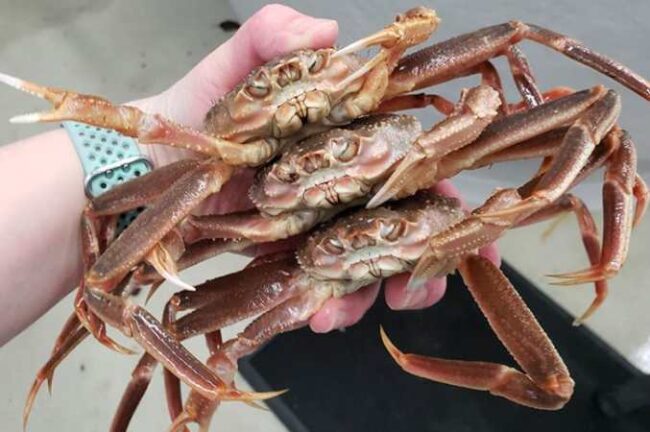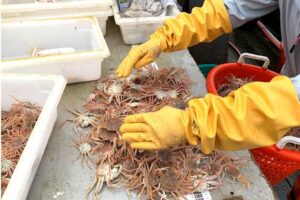Arctic conditions that dominated in the preindustrial Bering Sea are expected to continue to decline over the next 1-2 decades.

NOAA Fisheries scientists attribute the abrupt collapse of snow crab in Alaska to borealization, or an ecological shift from Arctic to sub-Arctic conditions in the southeastern Bering Sea due to human-caused climate change.
Cold-adapted species like snow crab are well suited to Arctic conditions. However, when borealization occurs, the ecosystem shifts to subarctic conditions that are less conducive to snow crab survival. Instead, they favor warm-adapted species and temperature marine ecosystems.
“What is particularly noteworthy is these boreal conditions associated with the snow crab collapse are more than 200 times likely to occur in the present climate (1.0° –1.5° of warming rate) than in the preindustrial era,” said Mike Litzow, lead author and director of the Alaska Fisheries Science Center’s Kodiak Lab. “Even more concerning is that Arctic conditions conducive for snow crabs to retain their dominant role in the southeastern Bering Sea are expected to continue to decline in the future.”
With further warming expected in the next 10 to 20 years, results indicate that the Arctic characteristics necessary for the snow crab stock may become scarce in the southeastern Bering Sea. Litzow and his team expect to see Arctic conditions in only 8 percent of future years in the southeastern Bering Sea. This percentage could decrease with higher warming rates expected in the future. If this occurs, it could potentially signal the northward displacement of the important commercial fishery from its traditional grounds.
A Closer Look at What Happened to Southeastern Bering Sea Snow Crab

Historically, snow crab have been a key part of the Arctic community in the southeastern Bering Sea. The Bering Sea is a marginal ice sea—it has ecological characteristics that are fundamentally shaped by the presence or absence of winter sea ice. Ice-covered areas are characterized by:
- Ice-associated primary production (algal blooms that occur under the sea ice) with high export to the seafloor communities
- Cold summer bottom temperatures produced during ice formation
- Arctic communities that are dominated by bottom-dwelling invertebrates, which include snow crabs
In 2018-2019, the snow crab population experienced a decline of greater than 90 percent. Previously, snow crab supported one of the most valuable commercial fisheries in the Arctic. The annual ex-vessel value for this fishery was estimated to be $227 million.
To measure the progression of borealization on snow crab abundance, scientists analyzed changes from between 1972 and 2022 in:
- Ice cover
- Bottom temperature
- Primary production dynamics
- Community composition for phytoplankton, zooplankton, and groundfish
They found a decline in sea ice, and an increase in:
-
Pseudocalanus copepod abundance
-
Bitter crab disease in snow crab (thought to be fatal), i
-
Areas of spring open-water algal blooms
-
Pacific cod abundance (a snow crab predator)
-
Summer bottom temperatures
These are all indications of a shift from an Arctic to a sub-Arctic regime. Scientists ruled out trawl fisheries bycatch to explain the mortality associated with the collapse because the estimated bycatch is orders of magnitude too small to explain this level of mortality.
Surprisingly, thermal stress due to elevated ocean temperatures didn’t appear to be the primary issue affecting snow crab survival during these years. In laboratory studies, scientists observed that juvenile snow crab were unaffected by temperatures of up to 8°C. At the height of the marine heatwave in the Bering Sea in 2018 and 2019, ocean temperatures in crab habitat remained below that critical 8°C threshold. However, scientists suspect that warmer water temperatures increased snow crab metabolism.
Unfortunately, available prey in the wild were insufficient to meet these new caloric demands. This effect may have been magnified by increasing crab density as the stock contracted to occupy shrinking cold-water habitat.
“It’s really this combination of factors working together that caused the snow crab collapse,” said Litzow. “All of these factors are a result of climate change brought about by human activity since the start of the industrial revolution in the early 1900s. They indicate a wholesale transition towards boreal conditions in the southeast Bering Sea during these warm years.”
Future Outlook for Snow Crab in the Southeastern Bering Sea

In 2022, there was some good news for snow crab. During the Alaska Fisheries Science Center annual bottom trawl survey, scientists observed a return to cooler water temperatures more typical of historic times. These cooler conditions benefited snow crab.
Scientists saw an increased number of juvenile snow crab in their survey. This provides hope for a short-term (in about 5 years) recovery in the abundance of the larger animals that are harvested by the fishery.
These findings are dependent on climate model projections of future climate change. Climate models have performed well in predicting average global temperature since the 1970s, providing confidence in the use of climate models to project future climate change. Even though climate model projections are less certain over regional scales as is the case here, scientists don’t expect these Arctic conditions to persist in the region over the long term.
“It’s really important that fishermen, scientists, communities, and resource managers recognize that one of the most productive marine ecosystems in the world is changing—faster than anyone expected,” Litzow said. “The time to act is now to think about how we are all going to adapt.”
Scientists hope their results give ecosystem managers and fisheries stakeholders a new framework for recognizing and adapting to the speed and magnitude of change occurring in places like the Bering Sea. In particular, the borealization index developed for this study may have broader applications for assessing the impacts on other important commercial, recreational, or subsistence species.\
